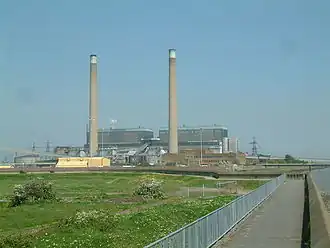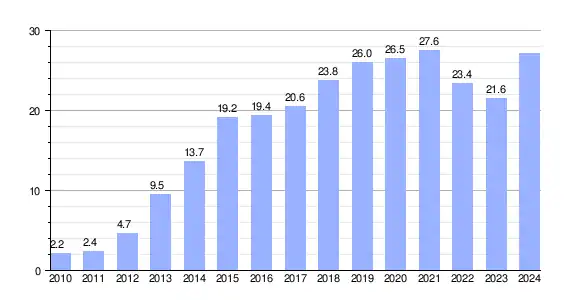Biomass in the United Kingdom

- Wind (30.0%)
- Nuclear (14.0%)
- Biomass (6.80%)
- Solar (5.00%)
- Hydro (2.00%)
- Storage (1.20%)
- Imports (14.1%)
- Coal (0.60%)
- Natural gas (26.3%)
Biomass generated 40.1 TWh of electricity in the United Kingdom in 2024 – about 7.1% of total UK output – from 3.8 GW of dedicated plant biomass and co-firing capacity.[2][3] The sector is dominated by large coal-to-biomass conversions such as Drax (2.6 GW) and Lynemouth (420 MW), with new plants planned such as the 299 MW Tees Renewable Energy Plant.[4][5][6]
History

In 2003 Drax Power Station began co-firing biomass as a renewable alternative to coal.[7]
- 2012 – the 750 MW Tilbury B hoped to become the world’s largest biomass unit[8] but was shut down in 2013.[9]
- 2013–2018 – Drax converted three of its six 660 MW units and built four 80 000-t storage domes.[4]
- 2021 – Coal generation fell below 2% of UK electricity; biomass overtook it for the first time.[10]
- September 2024 – the final coal plant at Ratcliffe-on-Soar closed, leaving converted biomass as the only solid-fuel baseload option.[11]
Capacity and generation
| vertical bar chart of between 2010 and 2024 |
 |
| Source: DESNZ Energy Trends 2025, Department for Energy Security & Net Zero. 27 March 2025. Retrieved 8 August 2025.[2] |
Major biomass power stations
| Station | Location | Output (MW) | Type | Fuel source | Notes |
|---|---|---|---|---|---|
| Drax | North Yorkshire | 2 580 | Conversion | Imported pellets (US SE; Canada) | Largest biomass plant in the world[4] |
| Lynemouth Power Station | Northumberland | 420 | Conversion | Imported pellets | Full biomass since 2018[5] |
| Snetterton | Norfolk | 44 | New build | Straw & chips | Supplies beet-sugar refinery |
| Wheldon Road CHP | Selby | 75 | CHP | Pellets | Supplies Drax rail unloading facility |
Heat sector
Biomass supplied 6 % of UK heat demand in 2023, mainly through industrial CHP and ~200 000 domestic pellet/wood-chip boilers accredited under the Renewable Heat Incentive (RHI).[12]
Transport biofuels
Under the Renewable Transport Fuel Obligation (RTFO) suppliers blended 1.89 billion litres of sustainable liquid biofuel in 2024 (9.1% by energy).[13]
Economics and subsidies
Between 2012 and 2024 Drax alone received £11 billion in Renewable Obligation and CfD support; 2024 top-up payments totalled £869 million.[14] Critics argue that burning imported wood is neither cost-effective nor carbon-neutral.[15]
Sustainability debate
A 2025 analysis by Ember found Drax emitted 13.3 Mt CO₂ in 2024 – more than the UK’s six most carbon-intensive gas plants combined.[16] NGOs and academics question the UK’s carbon-accounting rules that rate imported biomass as zero-emission at the point of combustion.[17] The proposed Tees Renewable Energy Plant is being challenged in court because of alleged environmental impacts.[18]
Policy and targets
The UK Biomass Strategy 2023 sets a hierarchy of uses favouring waste biomass and hard-to-electrify sectors and envisages up to 5 Mt CO₂ y⁻¹ of durable removals via BECCS by 2030.[19]
Records
- 28 December 2024: Bioenergy supplied 24% of UK electricity during a low-wind evening peak, the highest hourly share to date.[20]
See also
- Renewable energy in the United Kingdom
- Bioenergy in the European Union
- Biofuel in the United Kingdom
- Energy policy of the United Kingdom
References
- ^ "Britain's Electricity Explained: 2024 Review". National Grid ESO. 7 January 2025. Retrieved 10 January 2025.
- ^ a b "Energy Trends March 2025". Department for Energy Security & Net Zero. 27 March 2025. Retrieved 8 August 2025.
- ^ "Capacity and production statistics Q4 2024". Electric Insights. 28 March 2025. Retrieved 8 August 2025.
- ^ a b c "Drax Group Annual Report & Accounts 2024" (PDF). Drax Group. May 2025. Retrieved 8 August 2025.
- ^ a b "Lynemouth Biomass Conversion Project". Spencer Group. Retrieved 8 August 2025.
- ^ "Tees Renewable Energy Plant – project overview". MGT Teesside. Retrieved 8 August 2025.
- ^ "How to switch a power station off coal". Drax Global. 22 August 2018. Retrieved 16 August 2025.
- ^ Macalister, Terry (30 May 2011). "RWE to convert Tilbury power station into biomass plant". The Guardian. ISSN 0261-3077. Retrieved 16 August 2025.
- ^ Harvey, Fiona; Starkey, Natalie (5 July 2013). "RWE npower closes Tilbury biomass power station". The Guardian. ISSN 0261-3077. Retrieved 16 August 2025.
- ^ "The UK power sector in 2021". Ember. 11 January 2022.
- ^ "End of an era as Britain's last coal-fired power plant shuts down". The Guardian. 30 September 2024.
- ^ "Renewable Heat Incentive statistics – April 2024". DESNZ. Retrieved 8 August 2025.
- ^ "RTFO statistics 2024 – fourth provisional release". Department for Transport. June 2025. Retrieved 8 August 2025.
- ^ "Drax biomass subsidies in 2024". Ember. 3 April 2025. Retrieved 8 August 2025.
- ^ "Burning wood for power "not necessary" for UK energy goals". The Guardian. 22 January 2025.
- ^ "Drax remains UK's top carbon emitter with 16% rise". Energy Live News. 17 July 2025.
- ^ "UK bioenergy expansion poses fresh climate threat". Reuters. 19 February 2025.
- ^ "Teesside 'net zero' plant aids energy security, court hears". www.bbc.com. 5 March 2025. Retrieved 15 August 2025.
- ^ "UK Biomass Strategy – summary". Drax. 10 August 2023. Retrieved 8 August 2025.
- ^ "Bioenergy: the balancing beast". Electric Insights. 31 March 2025.